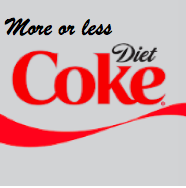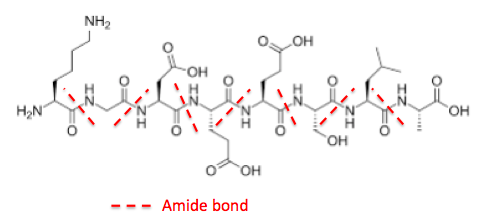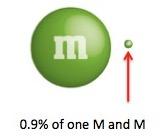Have you ever been out to dinner with a Nutrition Nazi, you know, one of those profoundly annoying people who scoff at your choice of food or beverage? Well, if you eat in a restaurant in New York, it's just about impossible to order a Diet Coke without someone glaring at you as if you set their grandmother on fire. And it is not uncommon to hear unsolicited, indignant opinions, for example, "I would never put something like that in my body!" (1) For example, something like this:

What's with the logo qualifier??
Well, here's a little extra ammo to give Mr. or Mrs. Snooty Pants Diet Soda Hater in case they run out of Snooty Pants comments about your beverage choice. Not only is your Diet Coke a drink unworthy of the Snooty Pants' of the world, but it isn't even calorie-free. Yep, there are calories, not many, but some. And the nature of the calories explains why the aspartame in your yummy Diet Coke is harmless - digestion (Figure 1).

Figure 1. The digestion of aspartame (aspartylphenylalanine methyl ester) produces one molecule each of aspartic acid, phenylalanine, and methanol. (If you think methanol will hurt you because it is converted into formaldehyde you better see this: Formaldehyde Is So Dangerous That You'd Be Dead Without It.
Aspartame consists of one molecule of aspartic acid which is chemically bound via an amide bond (red hash line) to a molecule of phenylalanine, which is bound to one molecule of methanol via an ester bond (blue hash line). Both aspartic acid and phenylalanine are amino acids, the components of proteins. Since proteins consist of a varying number of the 20 amino acids hooked together by amide bonds you could technically call aspartame the smallest protein (2), even though chemists would look at you as if you were out of your mind (3).
Figure 2 shows a fragment of hypothetical protein A. The fragment contains eight amino acids which are bound together by seven amide bonds. The digestion of amide bonds of proteins involves breaking the amide bonds, which releases the amino acids. An enzyme called peptidase, which is responsible for digesting proteins is the same enzyme that digests both fragment A and aspartame. So, your body treats aspartame like food. And like food, it contains calories.

Figure 2. A linear eight amino acid fragment of a protein held together by amide bonds (red hash lines).
So, since we are counting aspartame as a tiny protein, one would expect that it would have the same caloric count as a normal protein in the diet - 4 calories per gram; and it does. (4)
A 12-ounce can of Diet Coke contains 125 mg of aspartame, 113 mg of which is the "protein" aspartylphenylalanine (5). So, that can contains 0.452 calories. This is a very small number, but it is not zero. By comparison, a 12 ounce can of Coke contains 150 calories - 335-times that found in a Diet Coke.
How much is 0.452 calories in the real world? Not much.

So, be careful. The average American consumes 3,600 calories per day, the equivalent of 8,035 cans of Diet Coke. That stuff will kill you.
NOTES:
(1) And don't be surprised if the big mouth is on his or her fifth glass of overpriced Chardonnay and has a liver the size of a bison head.
(2) Any number of amino acids hooked together is called a peptide. A dipeptide contains two amino acids, a tripeptide has three.
(3) This is because proteins are much larger; ranging from 40-50 amino acids to more than 30,000. There has been a discussion about the minimum of amino acids that constitutes a protein. You don't want to be part of that discussion.
(4) Carbohydrates also have 4 calories per gram, fats have 9 calories per gram.
(5) Methanol makes up 10% of the weight of aspartame, so the total weight of what remains once the methanol is removed is 113 mg.
it states that there are 113 mg of protein in a 12 oz can of diet coke. Since there are 4 Calories in a gram of protein, there are then (0.113g protein / 12oz can) * (4 Calories / 1g protein) = 0.452 Calores / 12oz can.




